-

人教版高中英语必修3Canada-the true north说课稿4篇
Good afternoon, teachers, It’s my great pleasure to be here sharing my lesson with you.The content of my lesson is Senior English Book 3 Unit 5 Canada —— “The true North”.I’ll be ready to begin this lesson from five parts. Analysis of the teaching material,the teaching methods,the studying methods, the teaching procedure,and Blackboard design.First, let me talk about the teaching material.Part 1 Teaching Material:This unit is about the introduction of Canada. By studying of this unit,we’ll enable the students to learn the geography, population, main cities, and natural beauty, natural resources of Canada. Through the training of the unit, it also requires students to learn some Language skills such as the expressions of position and emotions.So it plays an important part in the English teaching in this book.After studying the teaching material and analyzing the rule of children’s growing of mind,I think the teaching aims are the followings:1.Knowledge objects:(1) make the students learn some new words and phrases(2) make the students understand the content of the lesson.2.Ability objects:(1)To develop the Ss’ abilities of listening, speaking, reading and writing. Especially reading and speaking ability.(2) learn to talk about the characters of Canada in English(3)To train the Ss’ ability of working in pairs.3.Emotion objects:(1)Enable students to understand the characters of Canada..(2)Stimulate Ss to work hard to make China stronger.Part 2 Teaching Methods:I think helping students learn to master new words and phrases and improve the students’ reading and speaking ability is import and the difficult.According to the analysis of the teaching material and the import points and the difficult points,I will use the following teaching methods : question-guiding approach; fast-reading and careful reading; multi-media teaching methods; discussion

人教版高中英语必修4Women of achievement说课稿4篇
Good morning, distinguished judges:It’s my honor to talk about my teaching ideas with you. Today my topic is Women of Achievement. My presentation consists of six parts: the analysis of teaching material and student, teaching aims, key and difficult points, teaching and studying method, teaching procedures and blackboard design.First, let’s focus on the analysis of teaching material. This lesson is from New Senior English for China Student’s Book 4 Unit 1, the reading part. The main topic of the passage is the introduction of a student of Africanwildlife. After this lesson, the students will learn more information about her studying chimps in Africa, and their reading and speaking abilities can be developed as well.The next part is the analysis of students. My students are in senior high students. They have learnt English for many years, they’ve known many words and sentences, but their speaking and reading abilities are still not very good. So I will practice their speaking and reading abilities through different exercises.According to the New Standard Curriculum and the present situation, I set the teaching aims as follows: firstly, knowledge aims. Students can grasp some new words, such as worthwhile, move off. Moreover, students can understand the content of the passage and get familiar with the topic of studying chimps in wildlife. Secondly, ability aims. Students can use reading strategies such as skimming and scanning in reading process. Thirdly, emotional aims. Students can have the awareness of protecting animals and care about animals.Based on the above analysis, the key point of this lesson is to get the main idea and the detailed information from the passage; the difficult point is to talk about the wildlife protection and use reading strategies.

人教版高中英语必修3Festivals around the World说课稿3篇
Teaching plan for Unit 1 book3Good morning, teachers. It’s my great pleasure to be here because I can share my lesson with you and I can learn a lot from it. I’ll begin my lesson from the following four parts, the teaching material, the teaching methods, the studying methods and the teaching procedure.Firstly, let me talk about the teaching material. The content of my lesson is the reading passage festivals and celebrations of Unit 1 Festivals around the world. This passage is about festivals and celebrations. By studying this passage, we’ll enable the students to know that festivals exit everywhere, and many of festivals in different countries celebrate similar ideas. As we all know, the reading passage is the center of each unit. If the Ss can learn it well, it will be helpful to make the Ss learn the rest of this unit.After studying the teaching material, I think the teaching aims are as the followings:1. Knowledge aims:(1) The Ss can master the usage of the important words andexpressions.(2)The Ss can use the __________________ (grammar) in the proper situation.Make students know about the festivals all over the world and the detail of the festivals, such as origin, content, and the date of the holiday festivals.2. Ability aims:(1) Students can talk about festivals and celebrations in English(2) To improve the student’s reading ability, especially their skimming and scanning ability.3. Emotion aims:Make the Ss know about the foreign festivals, and respect other countries’ custom.Next, let’s come to the important points and the difficult points.The important point is how to make the Ss understand the text better and the difficult point is how can they talk about it. secondly, Teaching Methods:1. task-based Language Teaching2. Computer assisted language teaching.3. question-and–answer methodThirdly, Studying Methods:

人教版高中英语必修4Theme parks说课稿3篇
The oldest and the most popular park in the worldenjoy the exciting activities thereget close to the life-size cartoon characters like Mickey Mouse and Donald Duck Step 3 Pre-reading1.What do you suppose a theme park is ?2.What do you think you can see in a theme park?(1.It is a kind of amusement park which has a certain theme – that the whole park is based on. 2.buildings, castles, statues, rare animals and birds, and so on.) Step 4 Reading ----- Theme Parks –---- Fun and More Than Fun1.Predict : Read the title and the pictures on P. 34 and PredictWhat is the meaning of the title “Theme Park – Fun and more than fun”?(The title means that theme parks are fun to visit, but that they can also be educational and can offer useful information.)2.Skimming Fast read and answer:What activities can we take in a theme park?Amusement park: Bumper car Merry-go-round slide bungee jumping Free-fall rides Horror films Pirate ship Ferris wheel roller coaster3.Scanning Read again and you will find various theme parks are mentioned in the passage . Then what are they ?Theme parks: Sports theme park History theme park Culture theme park Marine or Ocean theme Park Future park Science theme park Disneyland4.Careful reading and find the main idea of each paragraph:THEME PARKS---- entertaining/ educationalPara.1 Traditional parks are places to go for relaxation and to have time away from our busy lives.Para.2 Theme parks are different They’re large and full of things to do, see and buy.Para.3 Theme parks are built around a single idea or theme. One example is a sports park.Para.4 Another kind of theme park is historical more and cultural and can be educational.Para.5 Disneylandwas the first theme park. It is based on the fantasy life and characters of Disney’s films.Para.6 Some examples of educational theme parks include sea world parks and science parks.

人教版高中英语必修3Healthy Eating说课稿4篇
Language learning needs a context, which can help the learners to understand the language and then can product comprehensible output, so computer has the advantages to make the materials attractive.Part 3 Learning MethodsTask-based, self-dependent and cooperative learningPart 4 Teaching ProcedureStep One Lead-in“Interest is the best teacher.” Therefore, at the very beginning of the class, I should spark the students’ mind to focus on the centre topic “the band”. I’ll show some pictures of food to attract their attention and then bring some questions.Question:What kind of food they like?What should go into a good meal?The answers must relate to the diet. After this, the students will be eager to know something about a balance diet and this is the very time to naturally lead the class into Step 2Step 2 Reading for information: skimming and scanning In this step, I use Task-based Language Teaching method, which can give students a clear and specific purpose while skimming and scanning the context.Task 1 General ideaThe students will be asked to just glance at the title and the pictures of the passage, and then guess what they will read in the text. And they’ll be divided into groups of four to have a discussion.The purpose is to inspire the students to read actively, not passively. In addition, the task is to develop the students’ reading skill by making prediction and to encourage the students to express their thoughts in English and cooperate with each other.Task 2 Main idea of each paragraphCooperative learning can raise the students’ interest and create an atmosphere of achievement. Based on this theory, I divide the whole class into 4 groups to skim the whole text and get the main idea of each paragraph.

人教版高中英语必修4Working The Land说课稿3篇
Knowledge objectives:(1) to make Ss grasp the usage of words, expressions and sentence structures: statistics, struggle, thanks to, rid of, some patterns for persuasion, the “ing” form as subject and object;(2)to use learnt knowledge to persuade sb.Ability objectives:(1) to develop Ss’ reading skills(skimming, scanning, word guessing);(2) to improve Ss’ speaking, communicating and cooperating skills.Emotional objectives:to make Ss know the contribution of Yuan,and learn his spirit and his simple life time.Teaching important and difficult points:(1) some words, expressions and sentence structures mentioned above;(2)the content of the text;(3)training their reading and speaking skills.Teaching methods: CLT, TBLT,QT.Learning strategies: CLS, QLS, TBLS.Teaching procedures:Step 1 lead-in: (1) teacher plays a piece of recent news from CCTV about the harvest of the super hybrid rice, and ask students whether they know Yuan or not, and talk about him and his contribution.(2)Brain storm: let Ss describe Yuan in their minds including his appearance, his living condition and so on.Step 2 fast reading tasks:(1)teacher introduces Yuan and super hybrid rice(2)make Ss read the text as fast as possible with questions. Such as: what’s the general ideaof this passage? What’s Yuan’ dream? (skimming and scanning skill)Step 3 intensive reading tasks(1)let Ss read the text silently, find topic sentence of each paragraph and draw the difficult sentences and the knowledge what they don’t understand.(words guessing)(2)teacher and Ss talk about the important words, expressions and sentences together, and ask Ss to retell the content of the text.(summarizing and paraphrasing)(3)teacher summarize this part.(4) read again following the courseware.

人教版高中英语必修3The million pound bank note说课稿3篇
在接下来的细读环节,我套用了高考对阅读理解的考查方式设置了5个问题,分别为三个推理判断题,一个细节题和一个主旨大意题。学生需要对文章的内容进行分析、归纳、推理、猜测等高级思维活动才能做出正确的回答。【设计意图】这一过程是对学生进行细读的训练,培养学生获取特定信息和挖掘文章深层次信息的能力。第三环节:Intensive-reading (精读) 15′第三个环节精读,既是最重要的环节,也是突破本课重难点的关键。首先,让学生思考剧本中人物看到百万英镑前后的态度发生了怎样的变化。其次,让学生仔细阅读文章,找出可以表现人物态度变化的具体的语言和动作。最后,让学生总结人物的态度发生变化的根本原因是什么,从而引出Money Talks, 供学生思考。【设计意图】通过一系列的活动培养学生学习从人物的语言和动作探究人物的心理,使学生进一步体会戏剧语言的魅力,从而对文章背后所反映的社会问题进行思考,也为下一步的讨论环节做好铺垫。
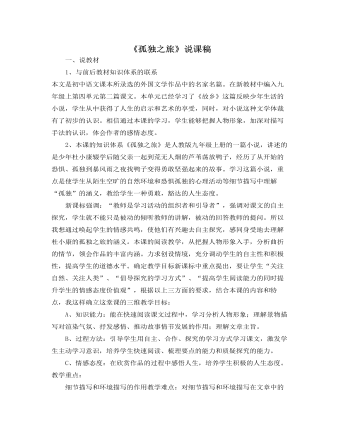
部编版语文九年级上册《孤独之旅》说课稿
二、说教法:我在设计这节课时努力实践新课程理念,充分突出学生的主体地位选择教学方法,整堂课以“在情节与现实写照中得到情感体验”为教学主线,通过整体感知,情节领悟,细节品味等途径,运用快速阅读,自主合作探究等方法,引导学生深入文本,感受主旨,与文章对话,与自己对话,与同学老师对话,在这种感受,体验、交流的课堂学习过程中逐步提升情感态度价值观。三、说学法:采用“自主、合作、探究”的学习方式,让学生自主进入文本,读出感受,通过小组合作交流探究来解决问题。【二·三理论依据】教学过程必须根据学生语文学习的特点,关注学生的个体的学习需求,爱护学生的好奇心,求知欲,充分激发学生的主动意识,倡导自主、合作、探究的学习方式,有助于学生学习方式的形成。
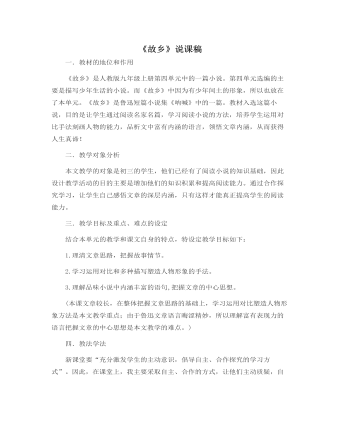
部编版语文九年级上册《故乡》说课稿
一.教材的地位和作用《故乡》是人教版九年级上册第四单元中的一篇小说。第四单元选编的主要是描写少年生活的小说。而《故乡》中因为有少年闰土的形象,所以也放在了本单元。《故乡》是鲁迅短篇小说集《呐喊》中的一篇。教材入选这篇小说,目的是让学生通过阅读名家名篇,学习阅读小说的方法,培养学生运用对比手法刻画人物的能力,品析文中富有内涵的语言,领悟文章内涵,从而获得人生真谛!二.教学对象分析本文教学的对象是初三的学生,他们已经有了阅读小说的知识基础,因此设计教学活动的目的主要是增加他们的知识积累和提高阅读能力。通过合作探究学习,让学生自己感悟文章的深层内涵,只有这样才能真正提高学生的阅读能力。三.教学目标及重点、难点的设定

部编版语文九年级上册《醉翁亭记》说课稿
1.创设情景法:利用多媒体课件,音乐、图片、文字相结合,激发学生学习兴趣和对本课的求知欲望,从而达到良好的教学效果。2.“自学——点拨——归纳”法:课前,教师根据教学目标设计出本课的“自学问题单”,让学生结合“自学问题单”先自学,预习课文;课堂上,小组合作讨论、解疑,教师适时点拨,最后归纳,逐步解决“自学问题单”中的问题,从而完成“教学目标”中的任务。四、说学法郭沫若先生曾说读书要“用自己的头脑来想,用自己的眼睛来看,用自己的手来做”。《语文课程标准》也特别强调:语文课程必须面向全体学生,使学生获得基本的语文素养,自主、合作、探究的学习方式应得到积极的提倡。九年级学生经过两年的初中学习后,已基本形成了一定的学习方法,也已经有了自主意识和自主学习的能力,所以,我采用了“自主、合作、探究”的学习方式。
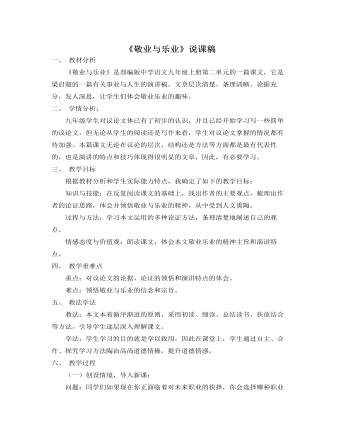
部编版语文九年级上册《敬业与乐业》说课稿
一、 教材分析《敬业与乐业》是部编版中学语文九年级上册第二单元的一篇课文,它是梁启超的一篇有关事业与人生的演讲稿。文章层次清楚、条理清晰、论据充分,发人深思,让学生们体会敬业乐业的趣味。二、 学情分析:九年级学生对议论文体已有了初步的认识,并且已经开始学习写一些简单的议论文。但无论从学生的阅读还是写作来看,学生对议论文掌握的情况都有待加强。本篇课文无论在议论的层次、结构还是方法等方面都是最有代表性的,也是演讲的特点和技巧体现得很明显的文章,因此,有必要学习。三、 教学目标根据教材分析和学生实际能力特点,我确定了如下的教学目标:知识与技能:在反复阅读课文的基础上,找出作者的主要观点,梳理出作者的论证思路,体会并领悟敬业与乐业的精神,从中受到人文熏陶。过程与方法:学习本文运用的多种论证方法,条理清楚地阐述自己的观点。
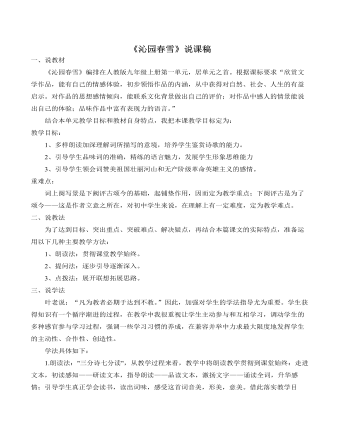
部编版语文九年级上册《沁园春·雪》说课稿
一、说教材《沁园春雪》编排在人教版九年级上册第一单元,居单元之首。根据课标要求“欣赏文学作品,能有自己的情感体验,初步领悟作品的内涵,从中获得对自然、社会、人生的有益启示。对作品的思想感情倾向,能联系文化背景做出自己的评价;对作品中感人的情景能说出自己的体验;品味作品中富有表现力的语言。” 结合本单元教学目标和教材自身特点,我把本课教学目标定为:教学目标:1、多样朗读加深理解词所描写的意境,培养学生鉴赏诗歌的能力。2、引导学生品味词的准确,精练的语言魅力,发展学生形象思维能力3、引导学生领会词赞美祖国壮丽河山和无产阶级革命英雄主义的感情。重难点:词上阕写景是下阙评古颂今的基础,起铺垫作用,因而定为教学重点;下阕评古是为了颂今——这是作者立意之所在,对初中学生来说,在理解上有一定难度,定为教学难点。

部编版语文九年级上册《岳阳楼记》说课稿
一、说教材《岳阳楼记》是人教版九年级上册第三单元文言文的第一篇。文辞具美、骈散结合。作者范仲淹以洗练的语言,先叙事后写景,进而由景入情,着重渲染了一悲一喜的情境,又因情而生发议论,表达了“不以物喜,不以己悲”的旷达胸襟和“先天下之忧而忧,后天下之乐而乐”的政治抱负,并以此劝勉友人。其人格魅力,千古传唱!二、说教学目标本单元意在让学生学习名家名篇,提高学生阅读古文的能力,品味文章优美的意境,培养审美情趣。结合本单元教学目标和课文自身特点,我从以下几个方面制定本课的教学目标:知识与能力:(1)积累文言知识,熟读成诵。(2)理解记叙、描写、抒情、议论多种表达方式融为一体的写法。过程与方法:诵读品味,学生在自主、合作、探究中展开与文本、与学生、与教师的对话。
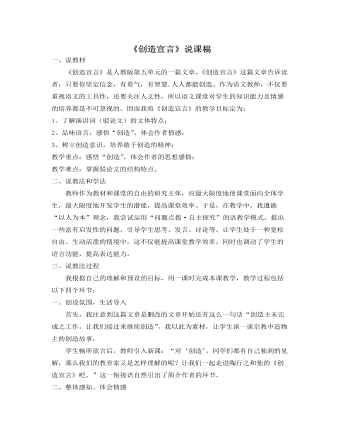
部编版语文九年级上册《创造宣言》说课稿
一、说教材《创造宣言》是人教版第五单元的一篇文章。《创造宣言》这篇文章告诉读者:只要你坚定信念,有勇气,有智慧.人人都能创造。作为语文教师,不仅要重视语文的工具性,还要关注人文性,所以语文课堂对学生的知识能力及情感的培养都是不可忽视的。因而我将《创造宣言》的教学目标定为:1、了解演讲词(驳论文)的文体特点;2、品味语言,感悟“创造”,体会作者情感;3、树立创造意识,培养敢于创造的精神;教学重点:感悟“创造”,体会作者的思想感情;教学难点:掌握驳论文的结构特点。二、说教法和学法教师作为教材和课堂的自由的研究主体,应最大限度地使课堂面向全体学生,最大限度地开发学生的潜能,提高课堂效率。于是,在教学中,我遵循“以人为本”理念,我尝试运用“问题点拨·自主探究”的语教学模式。提出一些富有启发性的问题,引导学生思考、发言、讨论等。
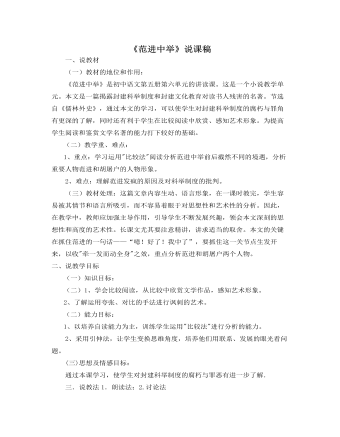
部编版语文九年级上册《范进中举》说课稿
一、说教材(一)教材的地位和作用:《范进中举》是初中语文第五册第六单元的讲读课。这是一个小说教学单元。本文是一篇揭露封建科举制度和封建文化教育对读书人残害的名著。节选自《儒林外史》,通过本文的学习,可以使学生对封建科举制度的腐朽与罪角有更深的了解,同时还有利于学生在比较阅读中欣赏、感知艺术形象。为提高学生阅读和鉴赏文学名著的能力打下较好的基础。(二)教学重、难点:1、重点:学习运用"比较法"阅读分析范进中举前后截然不同的境遇,分析重要人物范进和胡屠户的人物形象。2、难点:理解范进发疯的原因及对科举制度的批判。(三)教材处理:这篇文章内容生动、语言形象,在一课时教完,学生容易被其情节和语言所吸引,而不容易着眼于对思想性和艺术性的分析。因此,在教学中,教师应加强主导作用,引导学生不断发展兴趣,领会本文深刻的思想性和高度的艺术性。长课文尤其要注意精讲,讲求适当的取舍。
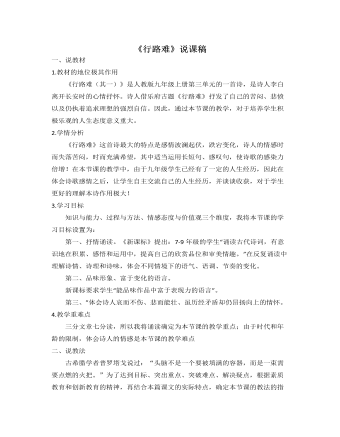
部编版语文九年级上册《行路难》说课稿
一、说教材1.教材的地位极其作用《行路难(其一)》是人教版九年级上册第三单元的一首诗,是诗人李白离开长安时的心情抒怀。诗人借乐府古题《行路难》抒发了自己的苦闷、悲愤以及仍执着追求理想的强烈自信。因此,通过本节课的教学,对于培养学生积极乐观的人生态度意义重大。2.学情分析《行路难》这首诗最大的特点是感情波澜起伏,跌宕变化,诗人的情感时而失落苦闷,时而充满希望,其中适当运用长短句、感叹句,使诗歌的感染力倍增!在本节课的教学中,由于九年级学生已经有了一定的人生经历,因此在体会诗歌感情之后,让学生自主交流自己的人生经历,并谈谈收获,对于学生更好的理解本诗作用极大!3.学习目标知识与能力、过程与方法、情感态度与价值观三个维度,我将本节课的学习目标设置为:
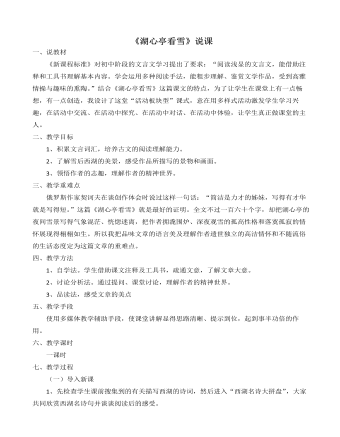
部编版语文九年级上册《湖心亭看雪》说课稿
一、说教材《新课程标准》对初中阶段的文言文学习提出了要求:“阅读浅显的文言文,能借助注释和工具书理解基本内容。学会运用多种阅读手法,能粗步理解、鉴赏文学作品,受到高雅情操与趣味的熏陶。”结合《湖心亭看雪》这篇课文的特点,为了让学生在课堂上有一点畅想,有一点创造,我设计了这堂“活动板块型”课式,意在用多样式活动激发学生学习兴趣,在活动中交流、在活动中探究、在活动中对话、在活动中体验,让学生真正做课堂的主人。二、教学目标1、积累文言词汇,培养古文的阅读理解能力。2、了解雪后西湖的美景,感受作品所描写的景物和画面。3、领悟作者的志趣,理解作者的精神世界。三、教学重难点俄罗斯作家契诃夫在谈创作体会时说过这样一句话:“简洁是力才的姊妹,写得有才华就是写得短。”这篇《湖心亭看雪》就是最好的证明。
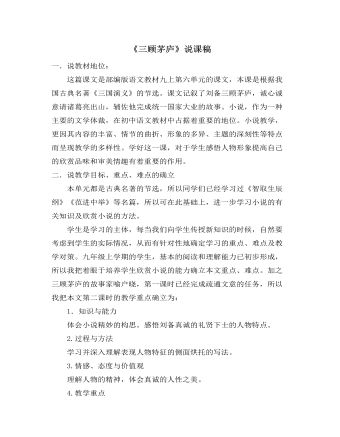
部编版语文九年级上册《三顾茅庐》说课稿
至此,教师可以明确:对刘备形象的塑造采用的手法以语言、动作描写为主,表现了刘备宽宏的气度和礼贤下士的品质,以及他兴复汉室的诚挚之心。那还有哪些是“为辅”的呢?还要引导学生关注小说情节中关、张二人的作用。我提出这样的讨论问题:“同去邀请诸葛亮,面对这些波折,关张二人有怎样的言行呢?这样刻画关张二人有什么作用?”我们看文中的关、张二人的言行。第一次请诸葛亮不遇,刘备与崔州平,聊了很长时间,张飞抱怨刘备“闲谈许久”,并无他言;第二次去隆中张飞抱怨天冷;第三次连关羽都觉得过分,认为那诸葛亮不过徒有虚名,不敢见而已。认为刘备礼遇太过了。张飞更直接,干脆我拿个麻绳把他捆来算了。这些言行,从侧面更显出刘备非凡的识人智慧。教师可以总结,通过与关羽、张飞二人对诸葛亮态度的对比,侧面烘托了刘备善识人才,渴求贤才的特点。
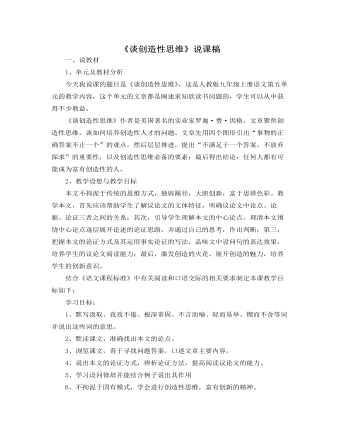
部编版语文九年级上册《谈创造性思维》说课稿
《谈创造性思维》作者是美国著名的实业家罗迦·费·因格。文章聚焦创造性思维,谈如何培养创造性人才的问题。文章先用四个图形引出“事物的正确答案不止一个”的观点,然后层层推进,提出“不满足于一个答案,不放弃探求”的重要性,以及创造性思维必备的要素;最后得出结论:任何人都有可能成为富有创造性的人。2、教学设想与教学目标本文不拘泥于传统的思维方式,独辟蹊径,大胆创新,富于思辨色彩。教学本文,首先应该帮助学生了解议论文的文体特征,明确议论文中论点、论据、论证三者之间的关系;其次,引导学生理解本文的中心论点,理清本文围绕中心论点逐层展开论述的论证思路,并通过自己的思考,作出判断;第三,把握本文的论证方式及其运用事实论证的写法,品味文中设问句的表达效果,培养学生的议论文阅读能力;最后,激发创造的火花,展开创造的魅力,培养学生的创新意识。
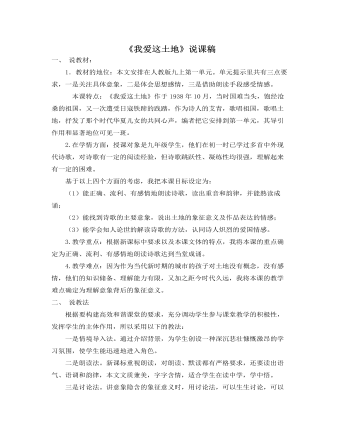
部编版语文九年级上册《我爱这土地》说课稿
本课特点:《我爱这土地》作于1938年10月,当时国难当头,饱经沧桑的祖国,又一次遭受日寇铁蹄的践踏,作为诗人的艾青,歌唱祖国,歌唱土地,抒发了那个时代华夏儿女的共同心声,编者把它安排到第一单元,其导引作用和显著地位可见一斑。2.在学情方面:授课对象是九年级学生,他们在初一时已学过多首中外现代诗歌,对诗歌有一定的阅读经验,但诗歌跳跃性、凝练性均很强,理解起来有一定的困难。基于以上四个方面的考虑,我把本课目标设定为:(1)能正确、流利、有感情地朗读诗歌,读出重音和韵律,并能熟读成诵;(2)能找到诗歌的主要意象,说出土地的象征意义及作品表达的情感;(3)能学会知人论世的解读诗歌的方法,认同诗人炽烈的爱国情感。3.教学重点:根据新课标中要求以及本课文体的特点,我将本课的重点确定为正确、流利、有感情地朗读诗歌达到当堂成诵。

